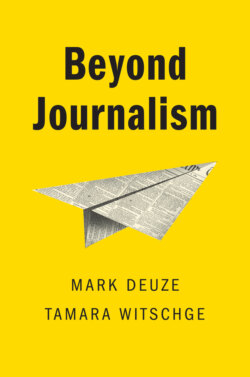Читать книгу Beyond Journalism - Mark Deuze - Страница 10
The state of the field
ОглавлениеJournalism has enjoyed a rich and relatively stable history of professionalization. This has contributed to a more or less consensual notion of its core values and ideals, often grounded in the practices and routines of newswork as organized within legacy media organizations, and shared among journalists and the public alike (Karlsson and Clerwall 2018). Scholars coming from a variety of disciplines have theorized this history, forming a relatively consistent body of knowledge codified in national and international handbooks and canonical readers. However, recent work and analysis suggests that the supposed core of journalism, as well as the assumed consistency of the inner workings of news organizations, are problematic starting points for journalism studies. In this project we challenge the operational coupling of journalism’s occupational ideology, professional culture, and sedimentation in routines and organizational structures (the newsroom) in the context of its reconfiguration as an increasingly post-industrial, entrepreneurial, and atypical way of working and of being at work.1 We aim to outline a way beyond individualist and institutionalist approaches to do justice to the current complex transformation of the profession. We propose a framework to bring together these approaches in a dialectical attempt to move through and beyond journalism as it has traditionally been conceptualized and practiced, allowing for a broader definition and understanding of the myriad practices that make up journalism.
Journalism, as a profession, has enjoyed a long and stable development in most countries around the world. Whether working under conditions of censorship, pressures of nation-building, or with expectations of providing a society with social cement, journalism is widely recognized and seen as a set of values, principles, and practices enacted in different ways and settings with a “sense of wholeness and seamlessness” (Hallin 1992: 14) around the world. Similarly, the field of journalism studies – the scholarly pursuit of knowledge about journalism – developed alongside its object into an increasingly sophisticated and consensual body of knowledge, range of research methodologies, and theoretical developments. This focus on coherence and consensus does not do justice to the insight that journalism is more than a neat sum of its parts, and to the need to accommodate a more dynamic and indeed unruly consideration of the profession. Journalism is transitioning from a coherent industry (largely organized around sedimented practices and ways of working) to a highly varied arrangement of journalistic practices and a diverse range of opportunities to be a journalist.
Scholars and educators tend to respond to this shift in two ways. One is to rally the troops, close ranks, and put significant effort in bringing coherence and stability (back) to the field. This gets established by producing impressive handbooks, canonical anthologies, readers, and companion volumes (and corresponding special issues of scholarly journals and conferences). Empirical approaches in this tradition center on comprehensive surveys and content analyses of journalists and journalism based on narrow definitions of the news industry offering conclusions about what journalism is and who journalists are (see Willnat, Weaver, and Choi 2013; Hanitzsch et al. 2011; Hellmueller and Mellado 2015).
A second trend in the field is to dive, head first, into the chaos. This proves to be an often exciting and bewildering experience, leading to a wide variety of studies and conceptualizations of journalism in a post-industrial era, often featuring particularistic work on emerging and more or less innovative genres, formats, and types of journalism. Theoretically, journalism research in this context enthusiastically explores the boundaries of the field (Carlson and Lewis 2015), or shows through a surge in ethnographic fieldwork how even the traditional “inside” of the profession – the newsroom – is not as coherent as it is generally made out to be (Anderson 2011). Conceptually, such work can be considered to be walking in the footsteps of Colin Sparks’s much earlier realization, that “from every point of view it seems sensible to adopt a more catholic definition of journalism and of the scope of the press” (1991: 66). The point is that the core functions and roles of journalism are practiced in so many different ways and places, that conventional distinctions (such as between newspapers and magazines, online and offline, inside or outside of the traditional newsroom) quite simply fail to recognize “one of the fundamental contemporary realities of the press and the actual dynamic of its development” (Sparks 1991: 66). Sparks’s notion of a “catholic” definition – a definition that includes a wide variety of practices – asks us to be more inclusive when it comes to allowing a myriad of practices, genres, and forms to be considered when defining (as well as studying and doing) journalism.
In this intervention we bring together these approaches to move beyond journalism, allowing for not so much a redefinition but a more inclusive appreciation and understanding of the field that in turn grounds the multiple case study approach in our work for this book. In doing so, our work sides with a growing number of interventions in the field to open up and consider complexity and hybridity; it aims to expand our toolkit to make sense of journalism and its role in society.
